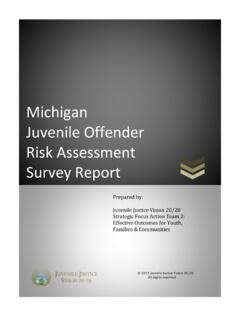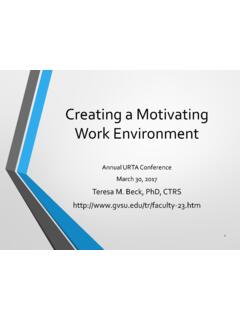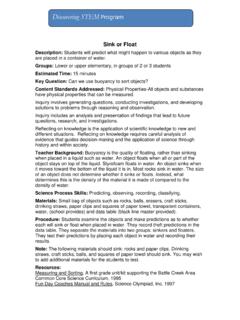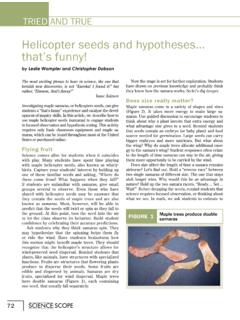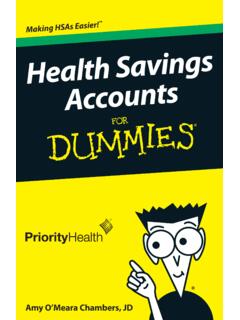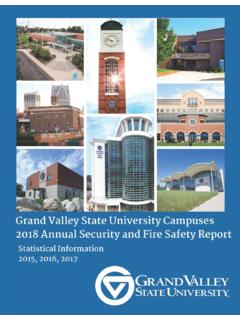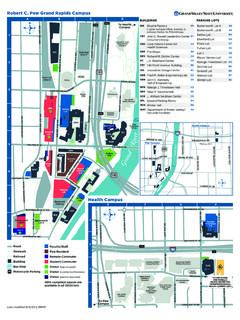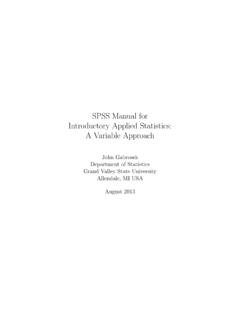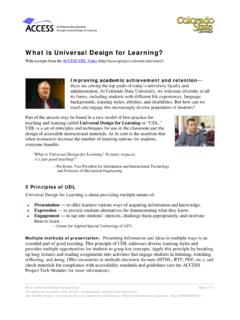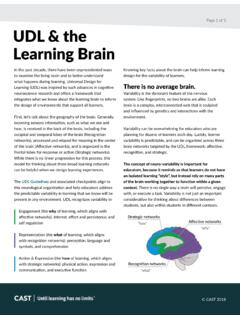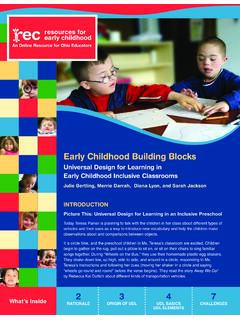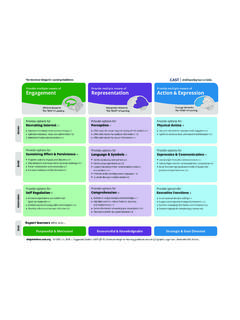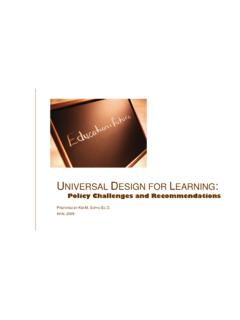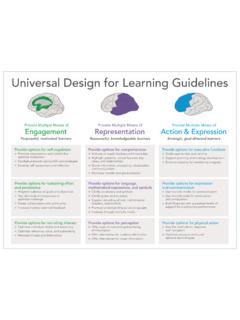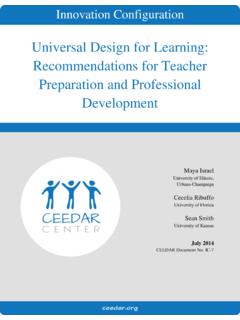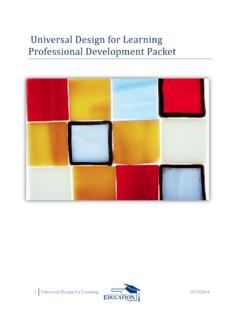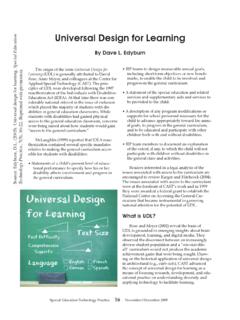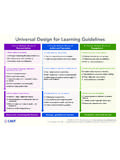Transcription of T WORKS Universal Design for Learning
1 Universal Design for LearningUDL provides a blueprint for creating educational goals, methods, materials, and assessments that work for everyone, while maintaining high achievement WORKST hasya Lumingkewas, 8, plays piano during a school concert at Maple Wood Elementary School in Somersworth, NH. The school utilized Universal Design for Learning as a way to reach all types of learners, with and without disabilities. From the film Design for Learning (UDL) is a research-based framework for designing curriculum that gives all students equal opportunities to learn. UDL provides a blueprint for creating educational goals, methods, materials, and assessments that work for everyone, while still maintaining high achievement standards.
2 A departure from traditional one-size-fits-all solutions, UDL offers flexible approaches that can be tailored and adjusted to meet the needs of each Design , initiated in the field of architecture, is a concept for creating places and things that are accessible to as many Guiding Principles of UDL CurriculumSource: Rose & Meyer, multiple means of presentation to allow varied ways of gaining information and knowledgeProvide multiple means of action and expression to allow alternatives for demonstrating knowledgeProvide multiple means of engagement to challenge appropriately, to motivate, and to allow learners to express and participate in their WORKS : Universal Design FOR Learning people as possible.
3 Curb cuts on sidewalks exemplify Universal Design . While first created to help people with wheelchairs move with greater ease, curb cuts not only improve access for those in wheelchairs, but also provide Universal improvement for people with strollers, bicycles, and skateboards. In the same way, Universal Design for Learning supports educators in developing teaching and Learning resources that can be used by the broadest range of students. Of course, educating people is much more complex than designing products and environments. So UDL principles aim to provide more than baseline physical access to classroom Learning materials by reducing other barriers to Learning barriers that are intellectual, social, emotional, cultural, and/or linguistic in nature.
4 Federal statute recommends UDL, defining it as a scientifically valid framework for guiding educational practice that (A) provides flexibility in the ways information is presented, in the ways students respond or demonstrate knowledge and skills, and in the ways students are engaged; and (B) reduces barriers in instruction, provides appropriate accommodations, supports, and challenges, and maintains high achievement expectations for all students, including students with disabilities and students who are limited English proficient. From pre-K to graduate school, classrooms typically are comprised of learners with wide-ranging abilities and backgrounds, including students with physical, sensory, and Learning disabilities, an array of cultural and linguistic backgrounds, different preferences and motivations for Learning , and varied levels of giftedness.
5 Effectively meeting the broad and evolving range of students needs is a constant challenge for teachers. UDL results in students becoming expert or master learners who are: a) strategic, skillful, and goal oriented, b) knowledgeable, and c) motivated to learn more. UDL emphasizes the importance of a flexible curriculum in meeting the diverse needs of learners. To this end, the UDL framework is supported by three guiding principles that seek to maximize Learning by minimizing barriers. Universal Design for Learning supports teachers efforts to meet the challenge of diversity by: Providing flexible instructional materials, techniques, and strategies. Customizing the content and Learning environment to meet the varied needs of their students (see the UDL guidelines above).
6 This technique is often referred to as differentiated instruction. Meeting the needs of the greatest number of users, making costly, time-consuming, and after-the-fact changes to curriculum unnecessary. Encouraging creative, flexible and resourceful Learning opportunities that are both high-tech and low-tech. Helping students master Learning itself, not merely a specific subject or set of skills. Allowing teachers to remove barriers that prevent students from mastering Learning . Many classrooms continue to use one medium or means of presentation the printed textbook which inherently cannot provide the flexibility that diverse learners require. As a result, UDL encourages the use of digital media.
7 By nature, digital media is flexible and can overcome many of the limitations of traditional materials. Unlike printed text, digital media provides options for sound, video, animation, volume control, text sizing, text to speech, speech to text, and marking and remarking the text for groups or individuals ( copy/paste, highlighting, bolding, underlining). For more information on the research basis for UDL and ongoing implementation efforts, visit the National UDL Center at SOURCES Center for Applied Special Technology (CAST). National Center on Universal Design for Learning . Ohio Center for Autism and Low Incidence (OCALI); Learn about UDL. Rose, & Gravel, (2010). Universal Design for Learning .
8 In B. McGaw, P. Peterson, & E. Baker (Eds.). International Encyclopedia of Education (3rd Ed.). Oxford: Elsevier. Rose, D. H., & Meyer, A. (2002). Teaching every student in the digital age: Universal Design for Learning . Alexandria, VA: principles aim to provide more than baseline physical access to clasroom Learning materials by reducing other barriers to Learning .

